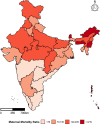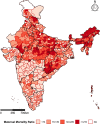Estimates and correlates of district-level maternal mortality ratio in India
- PMID: 36962393
- PMCID: PMC10021851
- DOI: 10.1371/journal.pgph.0000441
Estimates and correlates of district-level maternal mortality ratio in India
Abstract
Despite the progress achieved, approximately one-quarter of all maternal deaths worldwide occur in India. Till now, India monitors maternal mortality in 18 out of its 36 provinces using information from the periodic sample registration system (SRS). The country does not have reliable routine information on maternal deaths for smaller states and districts. And, this has been a major hurdle in local-level health policy and planning to prevent avoidable maternal deaths. For the first time, using triangulation of routine records of maternal deaths under the Health Management Information System (HMIS), Census of India, and SRS, we provide Maternal Mortality Ratio (MMR) for all states and districts of India. Also, we examined socio-demographic and health care correlates of MMR using large-sample and robust statistical tools. The findings suggest that 70% of districts (448 out of 640 districts) in India have reported MMR above 70 deaths-a target set under Sustainable Development Goal-3. According to SRS, only Assam shows MMR of more than 200, while our assessment based on HMIS suggests that about 6-states (and two union territories) and 128-districts have MMR above 200. Thus, the findings highlight the presence of spatial heterogeneity in MMR across districts in the country, with spatial clustering of high MMR in North-eastern, Eastern, and Central regions and low MMR in the Southern and Western regions. Even the better-off states such as Kerala, Tamil Nadu, Andhra Pradesh, Karnataka, and Gujarat have districts of medium-to-high MMR. In order of their importance, fertility levels, the sex ratio at birth, health infrastructure, years of schooling, postnatal care, maternal age and nutrition, and poor economic status have emerged as the significant correlates of MMR. In conclusion, we show that HMIS is a reliable, cost-effective, and routine source of information for monitoring maternal mortality ratio in India and its states and districts.
Copyright: © 2022 Goli et al. This is an open access article distributed under the terms of the Creative Commons Attribution License, which permits unrestricted use, distribution, and reproduction in any medium, provided the original author and source are credited.
Conflict of interest statement
The authors have declared that no competing interests exist.
Figures






Similar articles
-
Contributing factors for reduction in maternal mortality ratio in India.Sci Rep. 2024 Jun 27;14(1):14883. doi: 10.1038/s41598-024-65009-0. Sci Rep. 2024. PMID: 38937489 Free PMC article.
-
District level correlates of COVID-19 pandemic in India during March-October 2020.PLoS One. 2021 Sep 30;16(9):e0257533. doi: 10.1371/journal.pone.0257533. eCollection 2021. PLoS One. 2021. PMID: 34591892 Free PMC article.
-
Excess under-5 female mortality across India: a spatial analysis using 2011 census data.Lancet Glob Health. 2018 Jun;6(6):e650-e658. doi: 10.1016/S2214-109X(18)30184-0. Lancet Glob Health. 2018. PMID: 29773121
-
Maternal mortality inquiry in a rural community of north India.Int J Gynaecol Obstet. 1989 Aug;29(4):313-9. doi: 10.1016/0020-7292(89)90355-x. Int J Gynaecol Obstet. 1989. PMID: 2571532
-
Confidential review of maternal deaths in a South Indian state: current status and the way forward.Sex Reprod Health Matters. 2021;29(2):2009657. doi: 10.1080/26410397.2021.2009657. Sex Reprod Health Matters. 2021. PMID: 34928195 Free PMC article. Review. No abstract available.
Cited by
-
Contributing factors for reduction in maternal mortality ratio in India.Sci Rep. 2024 Jun 27;14(1):14883. doi: 10.1038/s41598-024-65009-0. Sci Rep. 2024. PMID: 38937489 Free PMC article.
-
Use of antenatal and delivery care services and their association with maternal and infant mortality in rural India.Sci Rep. 2022 Oct 3;12(1):16490. doi: 10.1038/s41598-022-20951-9. Sci Rep. 2022. PMID: 36192467 Free PMC article.
-
Roadblocks and solutions to planning surgical care for a billion Indians.BMJ Glob Health. 2022 Nov;7(11):e010292. doi: 10.1136/bmjgh-2022-010292. BMJ Glob Health. 2022. PMID: 36384949 Free PMC article. No abstract available.
-
Can administrative health data be used to estimate population level birth and child mortality estimates? A comparison of India's Health Information Management System data with nationally representative survey data.SSM Popul Health. 2022 Jun 23;19:101148. doi: 10.1016/j.ssmph.2022.101148. eCollection 2022 Sep. SSM Popul Health. 2022. PMID: 35795262 Free PMC article.
-
Does Empowering Women Influence Maternal Healthcare Service Utilization?: Evidence from National Family Health Survey-5, India.Matern Child Health J. 2024 Apr;28(4):679-690. doi: 10.1007/s10995-023-03823-0. Epub 2023 Nov 7. Matern Child Health J. 2024. PMID: 37934327
References
-
- WHO. Mortality and burden of disease. World Heal. Organ. 2021.
-
- World Health Organization (WHO). Maternal mortality: level and trends 2000 to 2017 Estimates by WHO, UNICEF, UNFPA, World Bank Group and the United Nations Population Division. 2019;:12.https://www.who.int/reproductivehealth/publications/maternal-mortality-2...
-
- Transforming our World: The 2030 agenda for Sustainable Development. United Nations Dev. Progr. 2015.https://sdgs.un.org/2030agenda
-
- Ministry of Health and Family Welfare G of I. Special Bulletin on Maternal Mortality in India 2014–16. SRS Bull 2018;:1–3.http://www.censusindia.gov.in/vital_statistics/SRS_Bulletins/MMRBulletin...
-
- Office of the Registrar General I. Special Bulletin on Maternal Mortality in India 2016–18. Sample Regist Syst 2020;:1–4.
LinkOut - more resources
Full Text Sources
